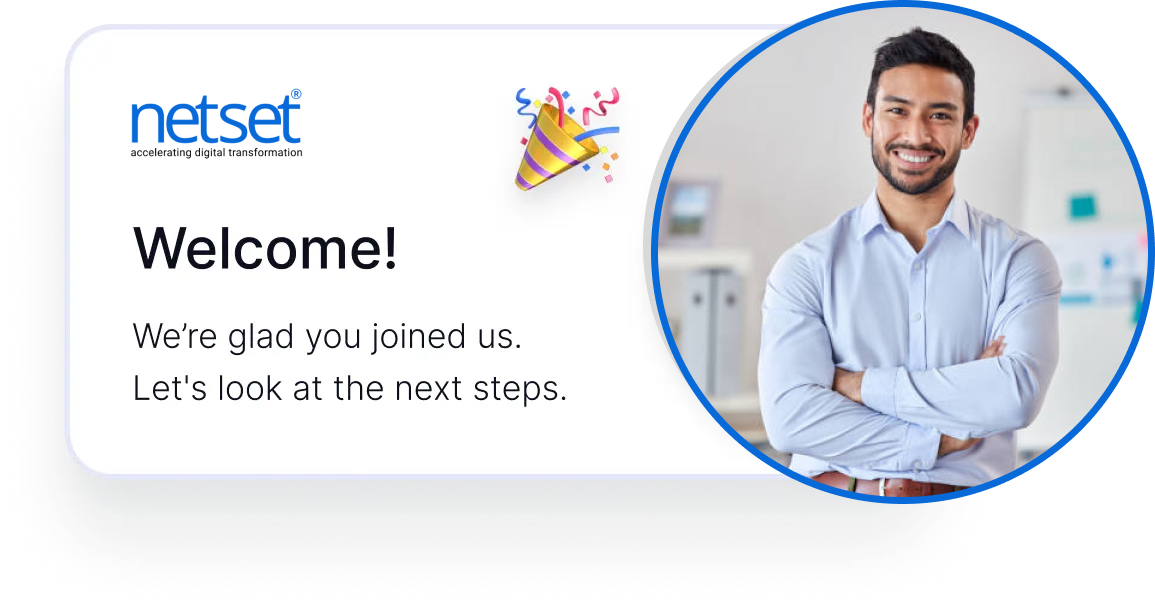









Easy-to-understand terms, customized for your business.
Excellent 4.7 out of 5 
Our team has extensive expertise to provide you with carefully selected talent in just a few days.

Let’s connect on a call, where you can share your unique needs, and we’ll match you with the ideal candidates.

Within an average of 2 days, receive a curated list of ready-to-work specialists, along with the option to book a call and interview them directly.

Onboard your new team members in 2 weeks or less. We’ll take care of onboarding tasks, ensuring your progress stays on track.
Netset Software offers expert Full stack Developers to create powerful, scalable AI solutions customized to your requirements.
Optimize your application development techniques with our team of skilled full stack developers, ensuring efficiency, cost-effectiveness, and accuracy.
Share with us the exact skills and expertise you need for your project. We’ll arrange a detailed call to thoroughly understand your requirements.
Within just a few days, receive a curated list of the most qualified, pre-vetted candidates tailored to your needs.
Schedule and conduct interviews with the shortlisted developers to evaluate their fit for your project. Select the ones who meet your criteria.
Begin your development process with confidence through a two-week, no-obligation trial period to ensure the perfect match for your team.
Frontend applications play a crucial role in creating user-friendly interfaces for online applications. It is crucial to ensure that the full-stack engineers you hire are well-versed in the latest front-end website planning tools, technologies, and strategies for creating engaging user experiences. Most projects necessitate familiarity with technologies such as jQuery, ReactJS, LESS, HTML5, Angular, and various others.
Being knowledgeable in both front-end and back-end technologies is essential for a full stack developer. Having expertise in developing backend apps for websites is a crucial skill for a full-stack developer. They should have a strong understanding of popular tools like Laravel, Django, Apache, NGINX, Jira, and other commonly used technologies.
Being a full-stack developer involves handling multiple aspects of a project. However, it's important to find someone who has a deep understanding of the subject matter. Having a strong grasp of frontend programs that enable the creation of interactive user interfaces is crucial, along with possessing fundamental design and graphics skills. This includes UI and UX design, scalability, and various other factors.
Having a solid understanding of databases is essential for full stack developers. It is crucial to avoid hiring a full-stack developer who only has basic knowledge or limited experience in database storage. Instead, hire a versatile consultant/developer who has experience with multiple DBMS systems like MongoDB, Oracle, MySQL, SQLServer, and more.
A full-stack developer must be proficient with various APIs and web servers. Ensure that the full-stack developers you hire are capable of writing server-side code and configuring web servers. Hire full-stack programmers who can design and implement APIS. Additionally, they should possess the ability to integrate with third-party APIs, including payment gateways, maps, and social media platforms.
Having a solid grasp of code versioning technologies is crucial for a well-rounded application development process. Experienced web developers have the ability to oversee and manage every aspect of the web development process using popular versioning tools such as Git. Experienced developers who are well-versed in using these platforms can efficiently handle any project.
When looking for a full stack developer, it is essential to take into consideration their level of expertise in both frontend and backend development. JavaScript, PHP, Python, Ruby, and.NET are well-known examples of popular programming languages that are used for both the frontend and the backend of websites.
Being a software engineer requires the ability to think quickly and efficiently solve problems. They must identify and resolve issues in code, thoroughly test their applications, and consistently enhance them to enhance user experience and optimize performance. When considering the hiring of full stack developers, it is important to assess their problem-solving abilities by assigning coding exercises or small projects and observing their approach.
Netset Software offers the opportunity to hire remote full-stack developers who possess extensive knowledge in both frontend and backend development. They can effectively code the different layers of your web and mobile app solutions.
Optimize your team's efficiency and budget by incorporating a versatile full-stack engineer who can seamlessly handle both backend and frontend development tasks. Prepare to swiftly launch your high-quality web and mobile applications in the market with one of the premier full-stack app development companies in USA. Get in touch with us now to enlist the services of full-stack developers in the USA.
Full stack developers provide a seamless experience by addressing all aspects of development. They integrate various parts of the process, ensuring a smooth, efficient, and cohesive workflow.
Full stack developers bring a versatile toolkit, proficient in both front-end and back-end technologies. They expertly manage databases, connect APIs, and ensure the project's smooth execution.
Engaging a full stack development company means working with experts who have a comprehensive view of your project. They manage all development stages and communicate effectively to deliver optimal results.
Hiring full stack developers can be more economical as they can handle multiple roles, reducing the need for a larger team. This approach helps keep your project within budget while maintaining high quality.
Full stack developers are adept at quickly adapting to changes in project requirements. Their broad skill set allows them to pivot and adjust seamlessly, ensuring the project remains on track.
With full stack developers, there's clear accountability from start to finish. They oversee the entire development lifecycle, ensuring consistency, reliability, and a unified vision for the final product.
Our developers have the necessary skills to excel as full stack developers! Just like an information security analyst, a fully functional website or app relies on a skilled team of full stack developers who possess expertise in both front end and backend technologies.
| Category | Technologies |
|---|---|
| Database & Programming Languages | Oracle, SQL, Redis, MongoDB, PostgreSQL, MySQL, Java, C#, Ruby, PHP |
| Front-end & Back-end | HTML5, CSS3, JavaScript, AngularJS, ReactJS, Vue.js, React-native, Bootstrap, Ruby, Node.js, Express.js, Laravel, Golang, Python, MeteorJS, Spring Boot, Java, Hibernate, Rails |
| Mobile App Technology | Android, iOS, Kotlin, Ionic, Flutter, React-native |
| UI Toolkits | UIKit, Foundation, Milligram, One-Nexus, Semantic UI, Pure CSS, Ink Interface Kit, Materialize.css, Topcoat, Petal, ReactAntDesign, Blueprint, Rebass, Grommet |
| Hosting Platforms | AWS EC2, Amazon Web Services (AWS), Docker, Heroku, Firebase, RackSpace, Kubernetes, Dapr, Azure, AWS Lambda, Google Cloud Platform (GCP) |
| Tools & Utilities | NPM, ELK stack, Mocha, Chai, REST, JSON, Gulp |
| Object-Relational Mapping, Version Control & Debug | Typeform, Mongoose, Sequelize, Git, Xdebug, Subversion, SVN |
Whether you work as an IT recruiter or a project manager, you are aware of how important it is to hire top developers for your project. When looking to hire a new full-stack developer to work on your online applications, utilize these sample interview questions.
Full-stack developers need to be knowledgeable about the following:
Programming Languages:Full-stack developers should be proficient in a variety of programming languages, including C++, Python, Ruby, PHP, Java, and others.
Front End technologies:Front-end technologies like HTML5, CSS3, JavaScript, etc. should be known to you. It's also crucial to have knowledge of third-party libraries like jQuery, Ajax, Angular, ReactJS, etc.
Frameworks:A range of development frameworks, including Spring, Spring Boot, Django, MyBatis, PHP, Hibernate, and others, must be mastered for this.
Databases and caches:You should be familiar with DBMS (Database Management Systems) technologies like MySQL, SQLite, Oracle, and MongoDB if you're a full-stack developer. Understanding the fundamentals of caching technologies like Redis, Memcached, and Varnish is beneficial.
Design Ability:To succeed as a Full-Stack web developer, you must also have a solid understanding of design. The applicant should also be familiar with the fundamentals of prototyping and UX/UI design.
A popular anti-pattern in asynchronous programming code is called Callback Hell, often known as the Pyramid of Doom (multiple functions running at the same time). This colloquial phrase refers to a lot of nested "if" statements or functions. Callback hell, to put it simply, is a circumstance in which there are numerous asynchronous functions. With so many callback procedures buried in so many layers, it might become fairly confusing because those functions depend on one another. The employment of callback functions results in cryptic, pyramid-shaped code that is challenging to read and maintain. Additionally, this makes it more challenging to determine the application's flow, which is the fundamental barrier to debugging and the source of this phenomenon's well-known name: Callback hell
REST (Representational State Transfer) has been a well-liked architectural approach for designing APIs (Application Programming Interfaces) for decades, but the rise of GraphQL in recent years poses a threat to REST. REST and GraphQL both generally try to transport data using internet protocols like HTTP. But how they go about it varies tremendously.
GraphQL1-Declarative data fetching is made possible by this query language for APIs, giving customers control over the data they want to get from the API.
2-High predictability is a hallmark of GraphQL. This allows you to send queries to your API and receive the precise responses you need without having to supply any information you don't need. Predictable results from GraphQL queries greatly increase their usability.
3-Although GraphQL's security features aren't as developed as REST's, they can nonetheless guarantee API security. For instance, GraphQL aids in integrating data validation, but users must determine how to employ authentication and authorization protocols.
4-With GraphQL, you can make a single API request to get all the information you require. There is no need to over- or under-fetch because you can define the structure of the information you require, and the server will return the same structure to you.
5-Mobile applications and several microservices are the key use cases for GraphQL.
REST1-It is an architectural approach for designing APIs that establishes a number of limitations for building web services.
2-The HTTP and URI methods that are utilized, on the other hand, affect the behavior of REST. As a result, while calling an endpoint, API users could be uncertain of what to anticipate.
3-REST can be used in a number of ways to enforce API security. To maintain REST API security, you can use a variety of API authentication strategies, such as HTTP authentication.
4-As a result, you can receive irrelevant data or need to submit repeated calls before receiving the correct data because REST APIs have fixed data structures that always return the requested data when they are accessed. Because of these flaws, the server's reaction time (to return information) may be delayed.
5-Simple apps and resource-driven applications are the main uses of the rest.
The practice of automating and merging code changes into a single software project, frequently several times per day, is known as continuous integration, or CI. This DevOps technique aims to make it possible for developers to integrate their code changes into a single repository for automated testing and builds. Before integration, the new code is checked for correctness using automated tools. The core of the CI process is a source code version control system. Additional checks, such as automated tests for the quality of the code and tools for reviewing the syntax and style, are added to the version control system.
Dealing with the various environments across many machines and platforms is one of the trickiest issues in software development. To swiftly release software, you must be able to separate your apps from your infrastructure using Docker. Containers are executable components that contain all the OS (Operating System) libraries and dependencies required to run an application in any environment, and they can be used by developers to package and run their applications. No matter what software is installed on the host, containers are small and come equipped with everything needed to run programs.
A design pattern for achieving the Inversion of Control is the Dependency Injection (DI) pattern (IoC). There are various techniques to build dependent objects outside of classes and make them accessible to classes. Dependency Injection uses the following three classes types:
Application Programming Interfaces (APIs) are standardized sets of guidelines and procedures that specify how hardware and software can talk to one another. REST APIs are defined as APIs that adhere to the representational state transfer (REST) design tenets. RESTful APIs are another name for REST APIs. Developers can make requests using RESTful APIs and get answers via HTTP requests. Data can be mapped from a cloud platform to a data warehouse or vice versa using REST API
It is technically impossible to entirely stop data scraping as long as the API's data is publicly available. However, throttle or infrequent limiting can be used to reduce bot activity—automated computer programs that run on the internet and carry out certain tasks. A device won't be able to make any number of requests within a given timeframe because of rare limitations. A 429 Too Many Attempts HTTP error is generated if more requests than allowed are made. Since each device's IP address is not unique, doing so could prevent the entire network from being able to access the API. It is crucial to record more information about the device than just its IP address.
The two-week no-risk trial period's goal is to get the developers on board and work with the team. If the developers meet your standards, you continue working together and pay their salaries for the first two weeks. But you won't have to pay anything if you don't like it during the trial period.
Full-stack developers are in high demand since they are a tremendous asset to any company. Their extensive expertise enables them to be adaptable, versatile, and agile. Reach out to Nestet if you're trying to recruit a skilled full-stack developer to streamline the hiring process.
With the help of Netset, a deep jobs network that identifies the top talent worldwide, you may locate a qualified full-stack developer who is flexible to work regarding your timezone.
To screen remote developers, Netset has developed the first and only Intelligent Talent Cloud. Instead of using self-reported experience from conventional resumes or job interviews, Netset checks developers on their actual talents. Each developer at Netset must pass our assessments in a variety of areas, including frameworks, data structures, algorithms, system architectures, and programming languages. Every Netset developer takes our automatic seniority assessment test, which consists of 57 calibrated questions in 5 categories: the impact of the project, the quality of the engineering, the communication, the people, and the direction.
You may find the top remote engineers with Netset with more than 100 different skills, including React, Node, Python, Angular, Swift, React Native, Android, Java, Rails, Golang, PHP, Vue, DevOps, Machine Learning, etc. Additionally, Netset provides developers based on seniority and tech stack.
With the help of Netset, businesses can now assemble a group of the top remote full-stack engineers in just 3-5 days. Full-stack developer interviews frequently involve queries about CORS or ideas like continuous integration and multithreading.
Years Experience
Project Launched
Man Hours Experience
Happy Customers
Client Retention
Your next-gen business apps are constructed with a powerful base of advanced android technologies with the latest development tools, catering to the necessary market demands.
Get going with a Business-Friendly Model that suits you perfectly.

Our fixed price paradigm best suits customers who wish to accomplish projects with limited scope and scalability with clear, predetermined and constant requirements.
Onboarding of small-sized projects is first initiated by estimating a feasible time and budget to create an MVP which minimizes project risks before development starts. This model keeps stable pricing adhering to the predictive calculations of work, time & money.
Fixed Time Period
Clear & Specified Requirements
Negligible Money Risk
No Pre/Post Changes
Time and Material model is tailored for customers coming up with long-term and complex projects which involve project executions including designing, bug fixing, testing, final deployment & support/maintenance.
What sets it apart from the previous one is the freedom to apply changes and modifications more freely within a defined time interval. Work begins after taking understanding and control over the visioned scope, rather the entire project.
Scalable & Flexible
Less Clear requirements
Less Consistent Workflow
Transparency & Collaboration


Dedicated Team model is ideal for customers looking for a prolonged business association for executing high-end and complex projects from start to finish. Say, projects intending to use Blockchain technology may fall under this category.
It’s the most flexible and adaptable among the list of three as it offers to make unfixed business changes, in real-time, as per the ever-increasing market demands. We deploy you with full rights to choose experts as employees to handle your entire project that is worked and supported remotely.
Enhanced Flexibility
Accountability and Transparency
High Money Investment
Wide & Deep Involvement

